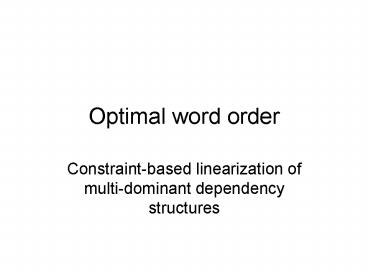Optimal word order PowerPoint PPT Presentation
1 / 26
Title: Optimal word order
1
Optimal word order
- Constraint-based linearization of multi-dominant
dependency structures
2
Structures and strings
- Structures represent syntactic and semantic
relations between words. - Strings do not consistently represent syn/sem
relations - unrelated neighbors
- George bought a new camel.
- related non-neighbors
- George bought a new camel.
- We hear strings, not structures.
- Strings are predictable from structures.
3
Phrase-structure trees represent dominance
precedence. Strings represent precedence.
George
bought
a
camel
4
Structures and strings
- Scenario I
- Structures exhaustively specify precedence
relations. Strings are simply lower-dimensional
projections of structures. - Scenario II
- Structures specify some precedence relations.
Strings observe these specifications
linearization specifications of a PF component. - a asymmetrically c-commands b ? a precedes b,
- but sister order unspecified
- Scenario III
- Structures do not specify any precedence
relations. String is read off via some
linearization procedure.
5
Grammar
Structure
Linearization Procedure
String
6
(No Transcript)
7
Word Order Optimization
- Gen produces possible strings for any given
structure
- Linearization constraints determine the optimal
string corresponding to the stricture - Ranking produce different linearization for the
same structure across languages
8
Structures
Grammar
Structure
Word Order Optimization
- Dependency structures
- specify only head-dependent relationship
String
9
Grammar
Grammar
Structure
- A dependency grammar specifies
- Possible heads for each word/category
Word Order Optimization
String
- Subcat frames for each word/category
- Constraints on structure
- single root
- only one word with null head
- no cycles
- no word is directly/indirectly self-dependent
10
Grammatical Roles
- May be configurationally defined or substantively
annotated
bought
subj
obj
George
camel
a
11
Constraints
- May refer to
- (dis)preferred alignment within the string
- beginning, center, edge, end
- (dis)preferred local alignment of head wrt
dependents - (dis?)preferred adjacency
- relative order
- externally motivated, e.g. prominence scale
12
Deriving base word order
- Greenbergs WO Universals
- Universal 1. In declarative sentences with
nominal subject and object, the dominant order is
almost always one in which the subject precedes
the object. - Assume that SVO, SOV, VSO are possible base word
orders - Prohibit all other word orders
- OSV, OVS, VOS
13
Deriving base word order
- DeclTopS Subject is default topic in
declarative sentences - Prom SgtgtO More prominent elements precede less
prominent elements (cf. Aissens Relational
scale) - VgtgtO verb precedes objects (partially a version
of HeadLeft) - VHeadEdge verb head must be at the edge of its
dependents (all dependents must be on one
side)(cf. Zepters LexHeadEdge)
14
Deriving WO with auxiliary verb
- Greenbergs WO Universals
- Universal 16. In languages with dominant order
VSO, an inflected auxiliary always precedes the
main verb. In languages with dominant order SOV,
an inflected auxiliary always follows the main
verb. - Typology
- VSO / AuxVSO
- SOV /SOVAux
- SVO / SAuxVO ??
15
Deriving WO with auxiliary verb
- 24 permutations possible for V, Aux, S, O
- 21 of them never occur
- Must maintain base order constraints
- Greenbergs generalization suggests
language-particular order depends on base order
16
Deriving WO with auxiliary verb
- Current constraints 1 new constraint exclude
all 21 undesirable outputs as harmonically bound.
- New constraint
- Aux and verb must be adjacent
- Formulated as generally as possible
- DH Dependent must be adjacent to head or to
its sister dependents
17
Aux
V
S
O
Assume structural subject dependent on Aux and
Verb
18
Deriving WO with auxiliary verb
- Base-order dependence falls out of the analysis
- Ranking which produces SVO also produces
exclusively SAVO - Ranking which produces SOV also produces
exclusively SOVA - Ranking which produces VSO also produces
exclusively AVSO - DH discriminates against other undesirable
candidates
19
Deriving WO of questions
- Incomplete (?) typology
- base/auxQ/baseQ
- SVO/ASVO/ASVO English
- SVO/AVSO/VSO Bulgarian
- SOV/AVSO/VSO Latin
- VSO/AVSO/VSO
20
Deriving WO of questions
- DecTopS is vacuously satisfied (active only in
declaratives) - Oops in this case, only possible question
orders are AVSO and VSO - How do we obtain English ASVO, ASVO?
- Or even Bulgarian AVSO/VSO?
- In situ questions?
21
Deriving WO of questions
- Two issues Aux epenthesis (English)
Faithfulness to base word order (In situ) - Auxiliary epenthesis is not universal. ? Some
constraint discriminates against it. - EpAux
- In situ questions FaithBaseOrder
- In situ questions introduce ambiguity MarkQ
22
Deriving WO of questions SVO
- We now have 8 constraints, 40320 grammars, but
only 4 question orders given FaithBaseSVO - SVO/SAVO/VSO/AVSO (Bulgarian)
- SVO/SAVO/VSO/ASVO (French)
- SVO/SAVO/SVO/ASVO (English-epenthesis)
- SVO/SAVO/ASVO/ASVO (English)
23
Deriving WO of questions SOV
- We now have 8 constraints, 40320 grammars, but
only 4 question orders given FaithBaseSOV - SOV/SOVA/VSO/AVSO
- SOV/SOVA/VSO/ASOV
- SOV/SOVA/SOV/ASOV
- SOV/SOVA/ASOV/ASOV
24
Deriving WO of questions VSO
- We now have 8 constraints, 40320 grammars, but
only 1 question orders given FaithBaseVSO - VSO/AVSO/VSO/AVSO
25
Conclusion
- Underlying (multi-headed) dependency structures
can be linearized using a restricted set of
constraints formulated from general templates
observing locality - Resulting linearization typologies closely
conform to Greenbergs observations - Future questions
- Are input structures universal or OT-outputs?
- Are all permutations considered or is Gen a
restricted read-off procedure?
26
References
- Aissen, J. (1999) Markedness and Subject Choice
in Optimality Theory. Natural Language
Linguistic Theory 17 673-711. - Greenberg, J.H. 1966. Universals of Language.
Cambridge. The M.I.T. Press - Grimshaw, Jane. (1997). Projection, Heads, and
Optimality. Linguistic Inquiry 28.3, 373-422. - Mel'cuk I., Dependency Syntax Theory and
practice, SUNY Press, Albany, 1988. - Prince, A P. Smolensky (1993) Optimality
Theory Constraint Interaction in Generative
Grammar. Rutgers University Center for Cognitive
Science Technical Report 2. - Zepter, A. (2003) Phrase-structure direction
Having a few choices. PhD, Rutgers Univ.

